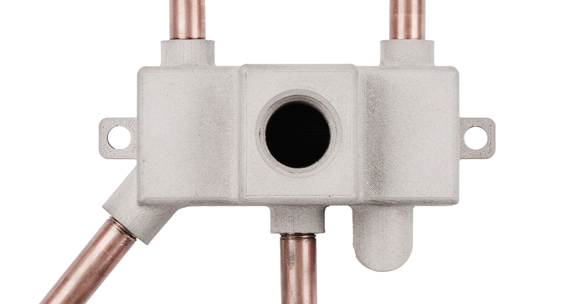Desktop Metal launches Studio System 2 Additive Manufacturing machine
February 2, 2021

Desktop Metal, Inc., headquartered in Burlington, Massachusetts, USA, has launched its Studio System 2 – a simplified, office-friendly metal Additive Manufacturing system aimed at low volume, pre-production and end-use applications.
The Studio System 2 incorporates a new, two-step process based on Desktop Metal’s Material Extrusion (MEX) technology it calls Bound Metal Deposition (BMD). The two-step process now eliminates the use of solvents, removing the debinding stage needed with earlier systems. All-new material formulations allow parts to be transferred directly from the printer into the furnace.
The result is said to offer a nearly hands-free experience, that also reduces consumables usage and overall system footprint.
“As Additive Manufacturing adoption advances worldwide, Desktop Metal continues to drive innovations that enable the technology to more effectively compete with conventional manufacturing processes,” stated Ric Fulop, CEO and co-founder of Desktop Metal.
“Our next-generation Studio System 2 takes the best features of the original Studio System+ and significantly improves upon them, delivering higher quality end-use metal parts through a more streamlined and accessible process, and within an even smaller footprint.”

The original Studio System, first debuted in 2017, was launched as an office-friendly metal AM system and consisted of a printer, debinder and furnace. This allowed the simplified, in-house production of low volumes of complex metal parts. The next-generation Studio System 2 retains all the critical features of the original Studio System, while delivering advancements that are said to make metal Additive Manufacturing even easier, more reliable and accessible.
Vacuum sintering in the Desktop Metal furnace, at temperatures of up to 1400°C, produces parts and mechanical properties that are similar to castings and reportedly meet or exceed Metal Powder Industries Federation (MPIF) standards.
The Studio System 2 is launching with 316L stainless steel, an excellent corrosion-resistant and general-purpose material used across a variety of industries for applications such as manifolds, nozzles, brackets, latches, and jewellery. A broad portfolio of additional materials, that take advantage of the new streamlined two-step process, is in active R&D, with new releases expected to rollout in 2021. In addition, the Studio System 2 will be backwards-compatible through the use of the debinder, with all materials previously supported by the Studio System, including 17-4PH stainless steel, 4140 low alloy steel, H13 tool steel, and copper.
The company’s Fabricate software features new, default print profiles tailored to the Studio System 2 process that simplify build preparation, while still providing users access to more than ninety customisable print settings. Fabricate also generates Separable Support structures with strategic splits to avoid locking during post-processing and fully automates thermal debind and sintering cycles.

“Based on the success of our original Studio System, we know companies around the globe are eager to adopt our new, more streamlined Studio System 2 process to produce difficult-to-machine parts featuring complex geometry like undercuts and internal channels,” added Fulop.
“Across manufacturing, tooling, automotive, consumer products and electronics, and medical applications, companies are sharing how Additive Manufacturing is challenging their design and engineering teams to think differently about how to optimise designs for best-in-class part success.”
The Studio System 2, which is set to begin worldwide shipments in the first quarter of 2021, will also be available through an upgrade for all existing Studio System customers.
















